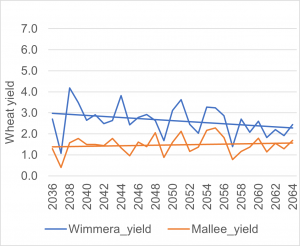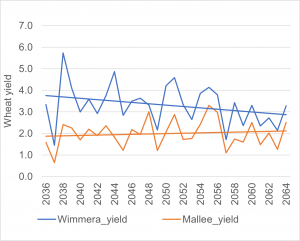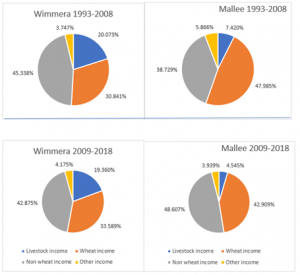ORM clients are certainly no stranger to hot and dry seasonal conditions. Due to 2019 being recorded as one of the driest on record, the industry is beginning to wonder exactly what climatic conditions we are likely to expect over the next 45 years. This question sparked a DELWP sponsored project with Monash University, who co-opted ORM as a key partner. The project explored the impacts of extreme temperatures on historic wheat yields in Northwest Victoria and then converted this into yield predictions under 10 climate change scenarios.
The impact of climate change on wheat yields
| The project utilized historical farm data from 37 farms for the years of 1993-2018 for the Mallee & Wimmera regions. The data was combined with climatic modelling to provide yield projections for the next 45 years based on different climatic scenarios.
Under ‘Hotter & Drier’ scenarios an increase in temperatures combined with low rainfall could have negative impacts on yield potentially resulting in long term yield decline & increased climatic variability. |
Yield Predictions under Hotter & Drier scenario

Within a ‘Warmer & Slightly Wetter’ & ‘Warmer & Wetter’ scenario wheat yields improve in both regions due to fewer freezing days, warmer temperatures as well as a higher rainfall.
Yield Predictions under Wetter and Slightly Warmer

Within both the Wimmera and the Mallee regions the adverse effects of frost and heat stress on yield is either fully or partially offset by increased rainfall. The data did identify key differences between the two regions. Within the Wimmera region frost was a major factor impacting upon wheat yields whereas heat stress during grain filling posed a much larger risk to yield within the Mallee region.
These scenarios raise the important question of which one is the most likely to eventuate over the coming decades with particular emphasis on whether we are likely to see a ‘Warmer & Wetter scenario or a ‘Hotter & Drier’ scenario.
The recently released IPCC (2021) Australasia Factsheet indicates that the Hotter & Drier scenario is more likely to eventuate for the Mallee & Wimmera region. The negative impact of the ‘Hotter & Drier’ scenario will be felt more in the Mallee in comparison to the Wimmera. Yields may fall by up to 30% compared with a 11% fall in the Wimmera.
Impact of climate change on farm profitability
For farms within the Wimmera and the Mallee regions it is typical to diversify across a number of crops and enterprises. On average, farms within the Wimmera obtained around 30% of their farm income from wheat and about 20% from livestock compared to over 40% from wheat in the Mallee region.
Within the Mallee region between the years of 1993 and 2018 the share of non-wheat income has significantly increased. Farmers are diversifying revenue streams to increase farm resilience. Future economic impacts will largely be determined by farm business’s ability to continue to adapt to climatic change to maintain farm profitability.
Revenue distributions of Wimmera/Mallee farmers from 1993-2018

Take Home Messages
The results indicate that future wheat yields may decline under hotter and drier climatic scenarios and the level of yield volatility within Northwest Victoria is likely to increase.
History has shown that farmers within the region have demonstrated the ability to respond to changing climatic conditions and challenges. Provided that farmers continue to effectively manage both production & price risk while building more resilient farming systems there is every reason to be optimistic about the future of farming in Northwest Victoria.
Key Climate Article Contact
We hope you enjoy the bulletin and encourage you to pass it on through your networks.
For more information about the project please contact us: